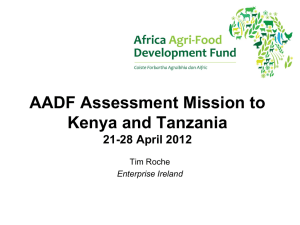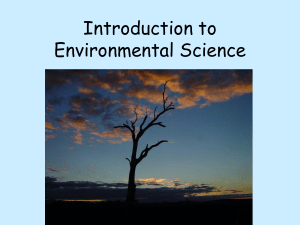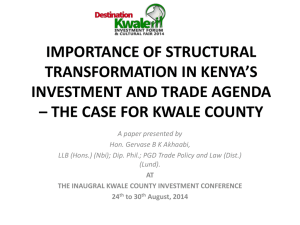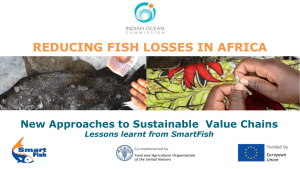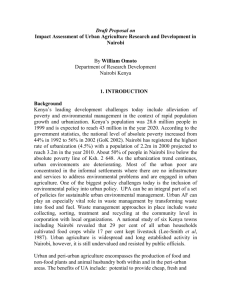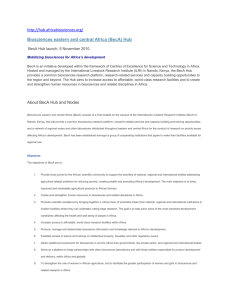Ganesh Prasad - School of Business
advertisement
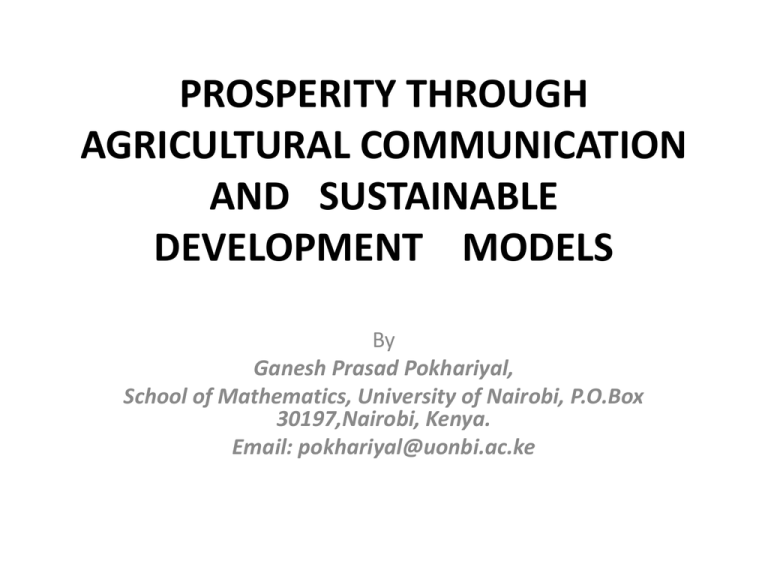
PROSPERITY THROUGH AGRICULTURAL COMMUNICATION AND SUSTAINABLE DEVELOPMENT MODELS By Ganesh Prasad Pokhariyal, School of Mathematics, University of Nairobi, P.O.Box 30197,Nairobi, Kenya. Email: pokhariyal@uonbi.ac.ke Abstract: • This paper describes various modes of communication and then suggests a communication models that could bring prosperity to the farming communities. • Marketing mechanisms operational in various countries and the notion of sustainable development are introduced. • Agriculture in selected developing countries and its potential is mentioned. Cont • The general model for sustainable development and stratified agricultural and development integrated model are developed. • Recommendations to accomplish sustainable development through these models are made, which will assist in achieving the desired prosperity of the nations. Agricultural Communication • sharing and exchanging information regarding: growing, harvesting and marketing of variety of agricultural products. • Agricultural stake holders :farmers, farm laborers, sellers of seeds, fertilizers and grown products, transporters, warehouse owners, insurance companies and consumers Cont • Non-agricultural stake holders include: industries; local, state and central government organizations; international bodies and nongovernmental organizations (NGO). • Agricultural extension: feed, fiber, food, alternative energy resources, natural resource management, rural development as well as local, regional, national and international economy. Nonhuman communication • Communication activities are not restricted to human beings only. • animals and plants also communicate quite effectively. • plant roots communicate in parallel with rhizome bacteria, with fungi and with insects in the soil. • These parallel sign-mediated interactions are governed by syntactic, pragmatic and semantic rules Communication Models • The first major model was given by Shannon and Weaver (1949) for Bell Labs • The original model was designed to embed the functioning of radio and telephone technologies and consisted of primary parts: sender, channel and receiver. Cont • Problems of the theory • Technical: which is due to accuracy of message transmission. • Semantic :which is due to the precision of meaning being conveyed. • Effectiveness: dealing with how effectively does the received meaning affect behavior. • There is likelihood of the following types of communication noises being involved in using this theory: • Environmental; physiological – impairment; semantic; syntactical; organizational; cultural and psychological. Cont • Transactional model of communication Developed by Barnlund (2008), has the basic premise that individuals are simultaneously engaging in sending and receiving the messages. Agricultural marketing • Moving of agricultural products from the farms to the consumers. • interconnected activities involved include: planning production growing and harvesting grading; packing transport storage agricultural, dairy, poultry and meat processing; distribution advertising and sales. Cont • Organizations in various countries that assist farmers • U.S : Agricultural Marketing Services (AMS) • S.A : National Agricultural Marketing Council (NAMC) • India: National Institute of Agricultural Marketing (NIAM) • Kenya: National Cereal and Produce Board, Sisal Board, Tea Board, Pyrethrum Board, Cotton Board, Kenya Dairy Board and Kenya Meat Commission Modern communication • Modern communication technologies open up the possibilities for market information services to improve information delivery. cell phones-SMS, FM radio stations, Internet-websites of various markets. Sustainable Development • United Nation released the Brundtland report in 1987 by defining, “sustainable development is development that meets the needs of the present without compromising the ability of future generations to meet their own needs”. • The concept of sustainable development is often broken out into three constituent parts: environmental sustainability, economic sustainability and sociopolitical sustainability. • A Venn diagram has been drawn to represent the intersection between these three parts (Barbier, 1987). Environmental sustainability • Requires that human activity only uses nature’s resources at a rate at which they can be replenished naturally. • Long term result of environmental degradation is the inability to sustain human life. • Such degradation on a global scale could imply extinction for humanity. Economic sustainability • Involves using the assorted assets of the unit effectively to allow it to continue functioning in a profitable manner over time and is concerned with seeking durable growth solutions. • Economic sustainability is about meeting diverse needs as well as providing livelihood and services to communities. Social-political sustainability • Is concerned with engagement, modification and advancement of institutional mechanisms. • It seeks pathways to durable social enrichment and development through vibrant and healthy political processes of society. Agriculture in India,Kenya,Uganda and Tanzania Country Land(sqkm) Population Workers in agriculture % G.D.P Highest contribution produced commodity India 2,973,190 1.21 B 65-70 16.6 Fruits, Vegetables, millet Kenya 587,000 35 M 80 29 Pyrethrum Uganda 241,038 35.9 M 90 Even with service sector Tanzania 945,087 46.9 M 80 ˜50 Cloves Problem area for agriculture • • • • • • • • • Slow growth: current agricultural practices. inadequate irrigation system Lack of extension services Poor road network. Excessive regulations Rudimentary market infrastructure Global warming Inability of government to implement various schemes. Aim of these countries • Achieving prosperity through: End of endemic poverty and reduction of inequality. Progress around social transition. Further political consolidation. Economic integration and regional geopolitical engagement. Conceptual Framework • The study in such areas is usually accomplished through the conceptual framework by identifying: independent variables, moderating variables, intervening variables and dependent variable (with its determinants). GENERAL MODEL FOR SUSTAINABLE DEVELOPMENT • The general model for sustainable development is given by the following multiple regression equation: • Y= α0 + α1 X1 +α2 X2 + α3 X3 + α4 X4 + α5 X5 + α6 X6 + α7 X7 + α8 X8 + α9 X9 + α10 X10 + α11 X11 + α12 X12 + α13 X13 + α14 X14 + α15 X15 + € , • where € denotes the error term. Model for India and East African Countries • India and East Africa have cultural diversity and as a consequence of this, their agriculture has fairly high degree of variability in terms of agroecological zones, inputs, the markets as well as needs. • This could be best accomplished through a stratified agricultural and development integrated model. • The model consists of three interconnected systems: farm, market and society. • Farm system:consists of land (its quality and agro-ecological zone); seed quality and its suitability; chosen crop and its maturity duration; irrigation facilities; manpower and machinery; communication facilities in the farm; electricity and other energy sources and weather forecast facility. • Market system:consists of proximity to market; road and other transportation network; demand and supply mechanism; economic status of people in and around the market; communication mechanism at the market and ethical practices followed in the market. • Society system:consists of people’s attitude (their desire and participation in development activities); environment for sustainable development; level and quality of education of people; short term and long term development plans; government and private support for sustainable development; suitable infrastructure and ethical behavior of people. DISCUSSIONS AND RECOMMENDATIONS • The general model can be adequately applied to the countries, where agricultural communication systems are fairly well established and people constitute reasonably good homogenous society. • Excessive materialist thinking, attitude of selfinterest and inflated ego prominently prevalent in society in India and the selected East African countries (Kenya, Uganda and Tanzania), hamper efforts for sustainable development. Cont • Mechanism of performance measurement for all persons involved would motivate people to work efficiently in achieving the set targets. • In future, communication is going to use”Cloud-based system” and “Data farms” for efficiency and bigger volumes. References • Baluska F; Marcuso, Stefano & Volkmann, Dieter (2006): Communication in plants: neuronal aspects of plant life; Taylor & Francis US, p 19 ISBN 3-540-28475-3 “The emergence of plant neurobiology as the most recent area of plant sciences”. • Shannon, C.E. & Weaver, W (1949): Mathematical theory of communication, Urbana Illinois; University of Illinois Press. • Barnlund, D.C. (2008): A transactional model of communication. In C.D. Mortensen (Eds.); communication theory (2nded., pp47-57), New Brunswick, New Jersey: Transaction. • United Nations (1987): “Repot of the world commission on environment and development” General Assembly Resolution 42/187, 11th December, 1987. • Barbier, E. (1987): The concept of sustainable economic development. Environmental conservation, 14(2); 101-110. • FAO STAT, 2010 data. Faostat.fao.org; (Wikipedia: retrieved on May 1, 2012) • Pokhariyal, Ganesh P (2007): Development strategies for subSaharan Africa; International Jour. On world peace, vol XXIV No.1, 83-102. • United States department of agriculture (October, 2011): Livestock and Poultry: World markets & trade”. • Handbook of Statistics on Indian Economy (2011): Reserve Bank of India. • Kibet, Caleb (2011): Major challenges facing Kenyan agriculture sector: Home blogs • United Nations (2009) Faostat: “Top production, in India, Kenya, Uganda, Tanzania. • World Bank (2008): India, Kenya, Uganda and Tanzania, country overviews. • Wikipedia: Retrieved on September 1, 2014. • Thank you for listening

